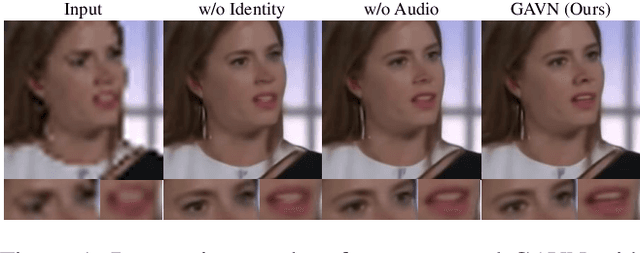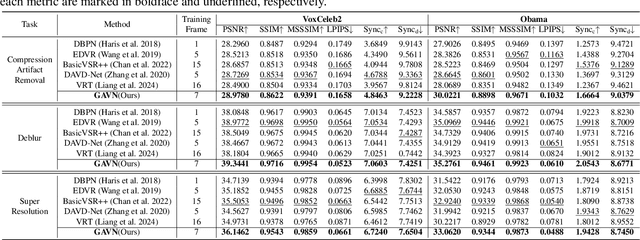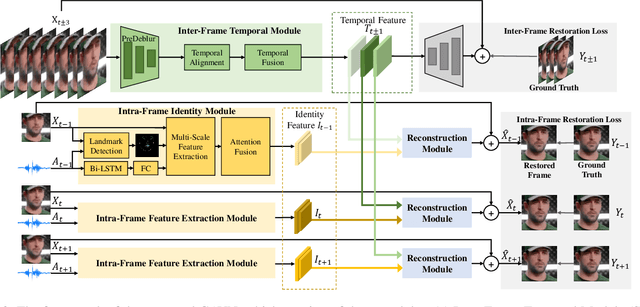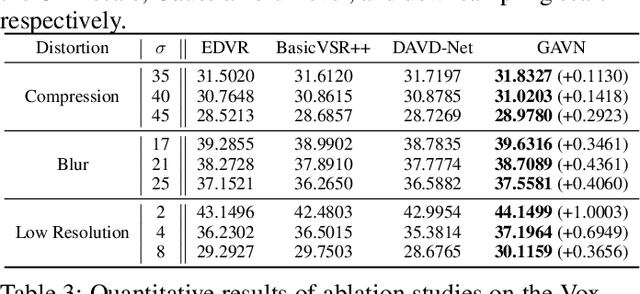Xiaohong Liu
dMLLM-TTS: Self-Verified and Efficient Test-Time Scaling for Diffusion Multi-Modal Large Language Models
Dec 22, 2025Abstract:Diffusion Multi-modal Large Language Models (dMLLMs) have recently emerged as a novel architecture unifying image generation and understanding. However, developing effective and efficient Test-Time Scaling (TTS) methods to unlock their full generative potential remains an underexplored challenge. To address this, we propose dMLLM-TTS, a novel framework operating on two complementary scaling axes: (1) trajectory exploration scaling to enhance the diversity of generated hypotheses, and (2) iterative refinement scaling for stable generation. Conventional TTS approaches typically perform linear search across these two dimensions, incurring substantial computational costs of O(NT) and requiring an external verifier for best-of-N selection. To overcome these limitations, we propose two innovations. First, we design an efficient hierarchical search algorithm with O(N+T) complexity that adaptively expands and prunes sampling trajectories. Second, we introduce a self-verified feedback mechanism that leverages the dMLLMs' intrinsic image understanding capabilities to assess text-image alignment, eliminating the need for external verifier. Extensive experiments on the GenEval benchmark across three representative dMLLMs (e.g., Lumina-DiMOO, MMaDA, Muddit) show that our framework substantially improves generation quality while achieving up to 6x greater efficiency than linear search. Project page: https://github.com/Alpha-VLLM/Lumina-DiMOO.
Embodied Image Compression
Dec 12, 2025Abstract:Image Compression for Machines (ICM) has emerged as a pivotal research direction in the field of visual data compression. However, with the rapid evolution of machine intelligence, the target of compression has shifted from task-specific virtual models to Embodied agents operating in real-world environments. To address the communication constraints of Embodied AI in multi-agent systems and ensure real-time task execution, this paper introduces, for the first time, the scientific problem of Embodied Image Compression. We establish a standardized benchmark, EmbodiedComp, to facilitate systematic evaluation under ultra-low bitrate conditions in a closed-loop setting. Through extensive empirical studies in both simulated and real-world settings, we demonstrate that existing Vision-Language-Action models (VLAs) fail to reliably perform even simple manipulation tasks when compressed below the Embodied bitrate threshold. We anticipate that EmbodiedComp will catalyze the development of domain-specific compression tailored for Embodied agents , thereby accelerating the Embodied AI deployment in the Real-world.
Using GUI Agent for Electronic Design Automation
Dec 12, 2025Abstract:Graphical User Interface (GUI) agents adopt an end-to-end paradigm that maps a screenshot to an action sequence, thereby automating repetitive tasks in virtual environments. However, existing GUI agents are evaluated almost exclusively on commodity software such as Microsoft Word and Excel. Professional Computer-Aided Design (CAD) suites promise an order-of-magnitude higher economic return, yet remain the weakest performance domain for existing agents and are still far from replacing expert Electronic-Design-Automation (EDA) engineers. We therefore present the first systematic study that deploys GUI agents for EDA workflows. Our contributions are: (1) a large-scale dataset named GUI-EDA, including 5 CAD tools and 5 physical domains, comprising 2,000+ high-quality screenshot-answer-action pairs recorded by EDA scientists and engineers during real-world component design; (2) a comprehensive benchmark that evaluates 30+ mainstream GUI agents, demonstrating that EDA tasks constitute a major, unsolved challenge; and (3) an EDA-specialized metric named EDAgent, equipped with a reflection mechanism that achieves reliable performance on industrial CAD software and, for the first time, outperforms Ph.D. students majored in Electrical Engineering. This work extends GUI agents from generic office automation to specialized, high-value engineering domains and offers a new avenue for advancing EDA productivity. The dataset will be released at: https://github.com/aiben-ch/GUI-EDA.
ATLAS: A High-Difficulty, Multidisciplinary Benchmark for Frontier Scientific Reasoning
Nov 18, 2025Abstract:The rapid advancement of Large Language Models (LLMs) has led to performance saturation on many established benchmarks, questioning their ability to distinguish frontier models. Concurrently, existing high-difficulty benchmarks often suffer from narrow disciplinary focus, oversimplified answer formats, and vulnerability to data contamination, creating a fidelity gap with real-world scientific inquiry. To address these challenges, we introduce ATLAS (AGI-Oriented Testbed for Logical Application in Science), a large-scale, high-difficulty, and cross-disciplinary evaluation suite composed of approximately 800 original problems. Developed by domain experts (PhD-level and above), ATLAS spans seven core scientific fields: mathematics, physics, chemistry, biology, computer science, earth science, and materials science. Its key features include: (1) High Originality and Contamination Resistance, with all questions newly created or substantially adapted to prevent test data leakage; (2) Cross-Disciplinary Focus, designed to assess models' ability to integrate knowledge and reason across scientific domains; (3) High-Fidelity Answers, prioritizing complex, open-ended answers involving multi-step reasoning and LaTeX-formatted expressions over simple multiple-choice questions; and (4) Rigorous Quality Control, employing a multi-stage process of expert peer review and adversarial testing to ensure question difficulty, scientific value, and correctness. We also propose a robust evaluation paradigm using a panel of LLM judges for automated, nuanced assessment of complex answers. Preliminary results on leading models demonstrate ATLAS's effectiveness in differentiating their advanced scientific reasoning capabilities. We plan to develop ATLAS into a long-term, open, community-driven platform to provide a reliable "ruler" for progress toward Artificial General Intelligence.
GeoX-Bench: Benchmarking Cross-View Geo-Localization and Pose Estimation Capabilities of Large Multimodal Models
Nov 17, 2025Abstract:Large multimodal models (LMMs) have demonstrated remarkable capabilities across a wide range of tasks, however their knowledge and abilities in the cross-view geo-localization and pose estimation domains remain unexplored, despite potential benefits for navigation, autonomous driving, outdoor robotics, \textit{etc}. To bridge this gap, we introduce \textbf{GeoX-Bench}, a comprehensive \underline{Bench}mark designed to explore and evaluate the capabilities of LMMs in \underline{cross}-view \underline{Geo}-localization and pose estimation. Specifically, GeoX-Bench contains 10,859 panoramic-satellite image pairs spanning 128 cities in 49 countries, along with corresponding 755,976 question-answering (QA) pairs. Among these, 42,900 QA pairs are designated for benchmarking, while the remaining are intended to enhance the capabilities of LMMs. Based on GeoX-Bench, we evaluate the capabilities of 25 state-of-the-art LMMs on cross-view geo-localization and pose estimation tasks, and further explore the empowered capabilities of instruction-tuning. Our benchmark demonstrate that while current LMMs achieve impressive performance in geo-localization tasks, their effectiveness declines significantly on the more complex pose estimation tasks, highlighting a critical area for future improvement, and instruction-tuning LMMs on the training data of GeoX-Bench can significantly improve the cross-view geo-sense abilities. The GeoX-Bench is available at \textcolor{magenta}{https://github.com/IntMeGroup/GeoX-Bench}.
MULTIBENCH++: A Unified and Comprehensive Multimodal Fusion Benchmarking Across Specialized Domains
Nov 14, 2025Abstract:Although multimodal fusion has made significant progress, its advancement is severely hindered by the lack of adequate evaluation benchmarks. Current fusion methods are typically evaluated on a small selection of public datasets, a limited scope that inadequately represents the complexity and diversity of real-world scenarios, potentially leading to biased evaluations. This issue presents a twofold challenge. On one hand, models may overfit to the biases of specific datasets, hindering their generalization to broader practical applications. On the other hand, the absence of a unified evaluation standard makes fair and objective comparisons between different fusion methods difficult. Consequently, a truly universal and high-performance fusion model has yet to emerge. To address these challenges, we have developed a large-scale, domain-adaptive benchmark for multimodal evaluation. This benchmark integrates over 30 datasets, encompassing 15 modalities and 20 predictive tasks across key application domains. To complement this, we have also developed an open-source, unified, and automated evaluation pipeline that includes standardized implementations of state-of-the-art models and diverse fusion paradigms. Leveraging this platform, we have conducted large-scale experiments, successfully establishing new performance baselines across multiple tasks. This work provides the academic community with a crucial platform for rigorous and reproducible assessment of multimodal models, aiming to propel the field of multimodal artificial intelligence to new heights.
FlashEdit: Decoupling Speed, Structure, and Semantics for Precise Image Editing
Sep 26, 2025Abstract:Text-guided image editing with diffusion models has achieved remarkable quality but suffers from prohibitive latency, hindering real-world applications. We introduce FlashEdit, a novel framework designed to enable high-fidelity, real-time image editing. Its efficiency stems from three key innovations: (1) a One-Step Inversion-and-Editing (OSIE) pipeline that bypasses costly iterative processes; (2) a Background Shield (BG-Shield) technique that guarantees background preservation by selectively modifying features only within the edit region; and (3) a Sparsified Spatial Cross-Attention (SSCA) mechanism that ensures precise, localized edits by suppressing semantic leakage to the background. Extensive experiments demonstrate that FlashEdit maintains superior background consistency and structural integrity, while performing edits in under 0.2 seconds, which is an over 150$\times$ speedup compared to prior multi-step methods. Our code will be made publicly available at https://github.com/JunyiWuCode/FlashEdit.
Blind-Spot Guided Diffusion for Self-supervised Real-World Denoising
Sep 19, 2025Abstract:In this work, we present Blind-Spot Guided Diffusion, a novel self-supervised framework for real-world image denoising. Our approach addresses two major challenges: the limitations of blind-spot networks (BSNs), which often sacrifice local detail and introduce pixel discontinuities due to spatial independence assumptions, and the difficulty of adapting diffusion models to self-supervised denoising. We propose a dual-branch diffusion framework that combines a BSN-based diffusion branch, generating semi-clean images, with a conventional diffusion branch that captures underlying noise distributions. To enable effective training without paired data, we use the BSN-based branch to guide the sampling process, capturing noise structure while preserving local details. Extensive experiments on the SIDD and DND datasets demonstrate state-of-the-art performance, establishing our method as a highly effective self-supervised solution for real-world denoising. Code and pre-trained models are released at: https://github.com/Sumching/BSGD.
AU-IQA: A Benchmark Dataset for Perceptual Quality Assessment of AI-Enhanced User-Generated Content
Aug 07, 2025Abstract:AI-based image enhancement techniques have been widely adopted in various visual applications, significantly improving the perceptual quality of user-generated content (UGC). However, the lack of specialized quality assessment models has become a significant limiting factor in this field, limiting user experience and hindering the advancement of enhancement methods. While perceptual quality assessment methods have shown strong performance on UGC and AIGC individually, their effectiveness on AI-enhanced UGC (AI-UGC) which blends features from both, remains largely unexplored. To address this gap, we construct AU-IQA, a benchmark dataset comprising 4,800 AI-UGC images produced by three representative enhancement types which include super-resolution, low-light enhancement, and denoising. On this dataset, we further evaluate a range of existing quality assessment models, including traditional IQA methods and large multimodal models. Finally, we provide a comprehensive analysis of how well current approaches perform in assessing the perceptual quality of AI-UGC. The access link to the AU-IQA is https://github.com/WNNGGU/AU-IQA-Dataset.
Audio-Assisted Face Video Restoration with Temporal and Identity Complementary Learning
Aug 06, 2025



Abstract:Face videos accompanied by audio have become integral to our daily lives, while they often suffer from complex degradations. Most face video restoration methods neglect the intrinsic correlations between the visual and audio features, especially in mouth regions. A few audio-aided face video restoration methods have been proposed, but they only focus on compression artifact removal. In this paper, we propose a General Audio-assisted face Video restoration Network (GAVN) to address various types of streaming video distortions via identity and temporal complementary learning. Specifically, GAVN first captures inter-frame temporal features in the low-resolution space to restore frames coarsely and save computational cost. Then, GAVN extracts intra-frame identity features in the high-resolution space with the assistance of audio signals and face landmarks to restore more facial details. Finally, the reconstruction module integrates temporal features and identity features to generate high-quality face videos. Experimental results demonstrate that GAVN outperforms the existing state-of-the-art methods on face video compression artifact removal, deblurring, and super-resolution. Codes will be released upon publication.
 Add to Chrome
Add to Chrome Add to Firefox
Add to Firefox Add to Edge
Add to Edge